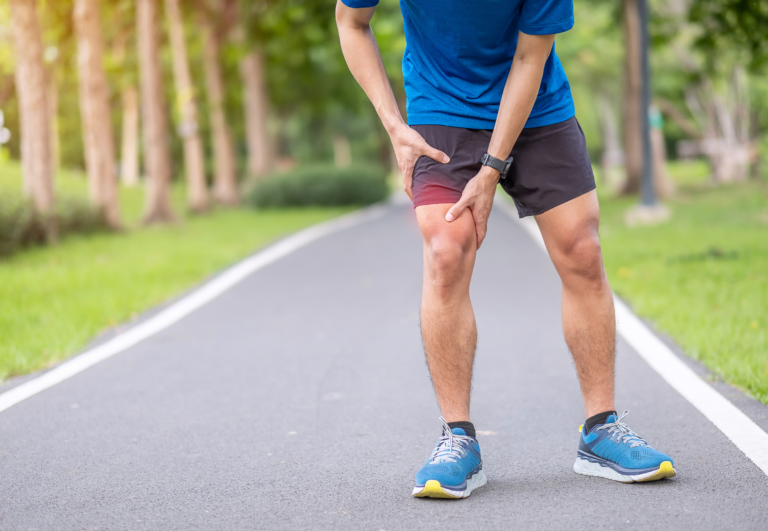Can Running Count As Leg Day? (In a Strength Training Program)
If you ever find yourself out of reach of a gym, you might consider running as a leg day replacement. But will a few miles of jogging really offer the same workout benefits as squats and deadlifts? Can running count as leg day?
Running does not count as leg day because it is primarily a cardiovascular exercise and does not provide the same intense muscle workout as weightlifting. Running consistently will help build muscle, but it is more likely to tone legs than strengthen them. Leg day typically includes intense, focused exercises like lunges, squats, and deadlifts.
Keep reading to learn about the different effects of running and weightlifting!

Is running enough for leg day?
Running is a wonderful form of exercise, and at this site, we are big fans of the habit. However, there are some results that it cannot produce. One of these is consistent muscle gains. While running may help tone the muscles you already have (especially the calves), it does not produce the same effect on the muscular system as weightlifting.
Running isn’t a great substitute for leg day because it offers a more limited range of motion and fails to isolate large muscle groups with the same intensity as weightlifting. Though running consistently will help build some muscle, the results will be much more marginal than a dedicated weightlifting routine.
Aerobic exercise, such as running, does have other benefits. Chiefly, running is seen as a heart-healthy practice. It has repeatedly been shown that this form of exercise decreases the risk of death from heart-related illnesses.
There are some things to consider, however, for ultra-marathoners and those who consistently participate in extremely vigorous forms of running. In fact, the American Heart Association only recommends that athletes participate in 75 minutes of vigorous aerobic exercise per week. This is because the strain put on the heart by extended, intense aerobic activity can actually cause the heart to wear out more quickly than it normally would.
Leg day vs. running
Leg day workouts are vastly different from the results one can expect from running.
Some of the differences between leg day and running include:
- Muscular isolation
- Aerobic output
- Recovery time
- Necessary equipment
Let’s look at each of these and see the differences between leg day and running.
Muscular isolation
Running engages most of the body but to a less extent than targeted workouts.
A typical leg day workout will consist of a series of movements to be completed under weighted resistance, which isolates specific muscles in the legs (i.e., hamstrings, quadriceps, calves, hip flexors, etc.). These movements will be attempted in a static environment and will be completed by forcing the muscle to move the weight using that muscle’s full range of individual motion.
Running, by contrast, is a total-body, dynamic workout that repeats the same movement repeatedly. This movement will usually not tax the muscles by pushing them to the full extent of their range of motion, and it will not isolate one or two muscle groups but will involve all of the muscle groups of the body: both the upper and lower body.
Aerobic output
Whereas running is not an intense physical workout, it does require extreme endurance and heart and lung strength.
The aerobic output required by runners is much greater than that of the average weightlifter. As mentioned above, the American Heart Association considers running a heart-healthy activity and should be a regular aspect of any exercise routine.
Weight resistance training, however, fails to produce this type of aerobic output, and thus its benefits are largely relegated to the building of muscle mass.
Recovery time
Regular runs – such as a few miles in the morning, not races or marathons – typically require relatively little rest. Lifting weights taxes the muscles in a way that running does not.
After a session of moderate weightlifting, a person may need 2-3 days of rest to allow their muscles to fully recover. This is why most experienced weightlifters separate their weekly routines into “arm days” and “leg days.”
Running, on the other hand, can be practiced more often. The recovery time between light runs can be as quick as 24 hours; however, more intense runs might require 72 hours.
Necessary equipment
While leg day can be completed without equipment, most would consider leg day to be an activity that requires a gym with weights, barbells, dumbbells, kettlebells, and weight belts. This means, to practice leg day, you either need to have a home gym or belong to a community gym.
However, running can be completed with only a quality pair of running shoes. This makes choosing running as a form of consistent exercise much more practical.
Although runners can also get carried away with purchasing additional accessories, the sport of running is a relatively simple one.
Can running replace leg day?
For most serious weight lifters, running will not be an adequate substitute for leg day.
In fact, anyone used to training regularly with weights should not attempt to run in place of their usual programming. Interrupting training with a long-distance run will not allow for optimal muscular development and may inhibit gains.
Running is a completely different form of exercise with a different focus and different benefits. Athletes should treat running as a separate tool in their toolbelt and should thus only use it for appropriate tasks such as building heart health and aerobic fitness.

What counts as a leg workout?
Running can certainly be a leg workout for someone not already involved in a resistance training program. However, the benefits of running on leg muscle development will be minimal.
Here are a few types of workouts that you may want to try if you’re more interested in building muscle:
- Bodyweight static exercises (air squats, lunges, one-legged squats, airplane RDL, calf raises)
- Bodyweight dynamic exercises (frog jumps, jump rope, box jumps, split jumps, hill sprints)
- Weighted exercises (squats, deadlifts, Power cleans, snatches)
Keep reading to learn more about each of these leg exercises.
Bodyweight static exercises
Static, bodyweight exercises such as air squats, lunges, one-legged squats, and airplane RDLs can help isolate various muscle groups and provide body weight resistance to help build muscles.
These exercises are safe and practical, as they do not require any equipment. Consistent participation in these exercises will increase lower body strength.
Bodyweight dynamic exercises
Dynamic bodyweight exercises have a similar effect to static bodyweight exercises; however, they also have the added benefit of taxing the cardiovascular system.
If you’re looking to spice up your strength training routine, try adding some frog jumps, jump roping, box jumps, split jumps, or hill sprints to your workout.
Weighted exercises
Strength resistance training is the fastest way to grow muscle and improve muscular output/efficiency.
While cleans and snatches especially encompass the whole body, squats, and deadlifts are relatively isolated movements focusing on the body’s lower half.
Weighted exercise is one of the most traditional forms of leg workouts. Specifically, most consider a few Olympic lifts essential to a well-rounded lower-body lifting routine. These lifts include squats, deadlifts, power cleans, and snatches.
Should you engage in running after leg day?
If you’re wondering, “Should I run on leg day,” the answer is no. Completing your gym and endurance training on the same day may impair the development of muscular endurance. This is because recovery from typical forms of weighted-resistance training can take up to 2-3 days.
Since this is the case, any attempts to perform endurance training within the same 24-hour period may produce more harmful effects than positive ones. Instead, you should consider spacing your resistance and endurance training throughout the week for the best results.
How to speed up recovery after leg day
There are a number of muscle recovery techniques that may improve your recovery time after a grueling leg day in the gym.
If you’re trying to get your muscles to mend themselves quickly so you can start running after leg workouts, try these science-backed techniques:
| Massage | This is the recovery technique with the largest effect on speeding up both actual and perceived muscular recovery after a single workout. This technique is most effective when applied for 20-30 minutes in the time period up to 2 hours after your workout. |
| Cold Exposure | Cold exposure also has a positive effect on recovery time using both cold water immersion and cryotherapy, although the positive effects tend to be smaller than massage. |
| Compression | Wearing compression garments during exercise has also been proven to present positive benefits to recovery times. |
Can running count as leg day?
Running does not count as leg day. Lifting weights and running have two very different effects on muscular development. You shouldn’t replace your normal leg day with a good run.
Can I complete leg day without lifting weights?
Yes, there are many body-weight exercises that can simulate the effect of weightlifting. These exercises include movements such as airplane Romanian deadlifts, single-leg squats, and lunges can all provide resistance and build muscle.
Should I run and do squats on the same day?
You should really try to avoid running and doing any form of lower-body lifting (including squats) on the same day. Your muscles need time to recover to both develop properly and avoid injury.







